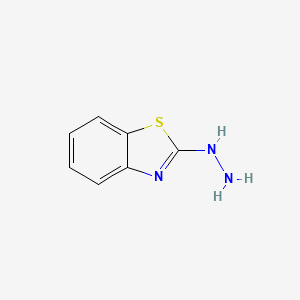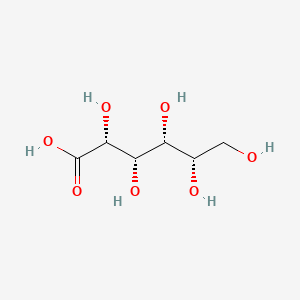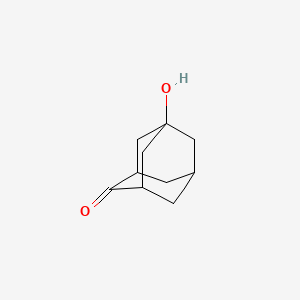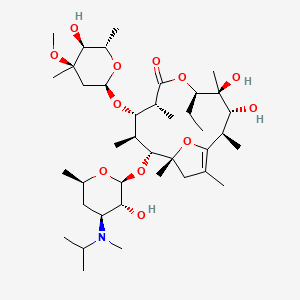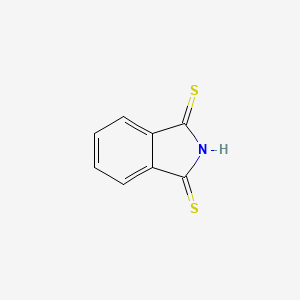
拉莫三嗪
概述
描述
拉莫三嗪是一种苯并三嗪类化合物,广泛用作抗癫痫药和情绪稳定剂。它主要用于治疗癫痫,包括局灶性发作、强直-阵挛性发作以及与 Lennox-Gastaut 综合征相关的发作。 此外,拉莫三嗪还用于稳定患有双相情感障碍患者的情绪 .
作用机制
拉莫三嗪通过稳定神经元膜和抑制兴奋性神经递质的释放发挥作用。它通过阻断神经元中的电压敏感性钠通道和电压门控钙通道来实现这一点。 这种作用减少了谷氨酸和天冬氨酸的过度释放,谷氨酸和天冬氨酸是参与癫痫发作和情绪调节的关键兴奋性神经递质 .
类似化合物:
卡马西平: 另一种用于类似适应症但具有不同化学结构的抗癫痫药。
丙戊酸: 用于癫痫和双相情感障碍,但它具有更广泛的作用机制,影响多种神经递质系统。
拉莫三嗪的独特性: 拉莫三嗪因其苯并三嗪结构而独一无二,这使其与其他抗惊厥药区别开来。 它具有相对良好的副作用特征,并且不需要定期进行实验室监测,使其成为许多患者的首选 .
科学研究应用
拉莫三嗪具有广泛的科学研究应用:
化学: 用作三嗪化学和反应性研究的模型化合物。
生物学: 研究其对神经元活动和神经递质释放的影响。
医学: 对其在癫痫和双相情感障碍中的治疗作用进行了广泛研究。
工业: 用于开发新的药物制剂和药物递送系统 .
生化分析
Biochemical Properties
Lamotrigine plays a crucial role in biochemical reactions by interacting with various enzymes, proteins, and other biomolecules. It primarily inhibits voltage-sensitive sodium channels and voltage-gated calcium channels in neurons, reducing the release of excitatory neurotransmitters such as glutamate . This inhibition stabilizes neuronal membranes and prevents excessive neuronal firing, which is beneficial in controlling seizures and mood swings.
Cellular Effects
Lamotrigine affects various types of cells and cellular processes. It influences cell function by modulating cell signaling pathways, gene expression, and cellular metabolism. In neurons, Lamotrigine inhibits the release of excitatory neurotransmitters, thereby reducing neuronal excitability . This modulation of neurotransmitter release impacts cell signaling pathways and gene expression, leading to stabilized mood and reduced seizure activity.
Molecular Mechanism
The molecular mechanism of Lamotrigine involves its binding interactions with biomolecules, enzyme inhibition, and changes in gene expression. Lamotrigine binds selectively to inactivated voltage-sensitive sodium channels, inhibiting sodium currents and stabilizing neuronal membranes . It also inhibits voltage-gated calcium channels, further reducing the release of excitatory neurotransmitters . These actions contribute to its antiepileptic and mood-stabilizing effects.
Temporal Effects in Laboratory Settings
In laboratory settings, the effects of Lamotrigine change over time. The compound is rapidly absorbed and reaches steady-state plasma concentrations within five days . Lamotrigine exhibits autoinduction within the first two weeks of therapy, which may prolong the time to steady state . Long-term effects observed in in vitro and in vivo studies include changes in bone density and potential risks of osteoporosis and osteopenia .
Dosage Effects in Animal Models
The effects of Lamotrigine vary with different dosages in animal models. In mice and rats, the oral median lethal doses (LD50) are 245 mg/kg and 205 mg/kg, respectively . At lower doses, Lamotrigine induces lethargy and somnolence, while higher doses can cause life-threatening cardiac arrhythmias, seizures, and death . These findings highlight the importance of careful dosage management in clinical settings.
Metabolic Pathways
Lamotrigine is metabolized primarily through glucuronidation by UDP-glucuronosyltransferases in the liver . The principal pathway involves the formation of Lamotrigine N2-glucuronide, which is then excreted in the urine . This metabolic pathway is influenced by genetic polymorphisms, which can affect the clearance and response to Lamotrigine .
Transport and Distribution
Lamotrigine is well absorbed with a bioavailability approaching 100% . It is distributed within the body with a volume of distribution ranging from 0.9 to 1.3 L/kg . Lamotrigine is transported across the blood-brain barrier, likely involving organic cation transporters . It accumulates in the kidneys and is extensively metabolized in the liver .
Subcellular Localization
Lamotrigine’s subcellular localization involves its interaction with sodium channels in neuronal membranes . It binds to inactivated sodium channels, causing a tonic inhibition of sodium currents . This interaction primarily occurs in the neuronal membranes, contributing to its antiepileptic effects.
准备方法
合成路线和反应条件: 拉莫三嗪是通过多步合成过程合成的。合成始于 2,3-二氯苯甲酰氯与水合肼反应形成 2,3-二氯苯甲酰肼。 然后用溴化氰将该中间体环化,生成 3,5-二氨基-6-(2,3-二氯苯基)-1,2,4-三嗪 .
工业生产方法: 拉莫三嗪的工业生产涉及优化反应条件,以确保高产率和纯度。 该工艺通常包括结晶、过滤和干燥等步骤,以获得适用于药用形式的最终产品 .
化学反应分析
反应类型: 拉莫三嗪经历各种化学反应,包括:
氧化: 拉莫三嗪可以被氧化形成其 N-氧化物衍生物。
还原: 还原反应可以将拉莫三嗪转化为其相应的胺衍生物。
常见试剂和条件:
氧化: 常见的氧化剂包括过氧化氢和过酸。
还原: 使用氢化锂铝和硼氢化钠等还原剂。
主要产物:
氧化: N-氧化物衍生物。
还原: 胺衍生物。
取代: 取代的苯并三嗪衍生物
相似化合物的比较
Carbamazepine: Another antiepileptic drug used for similar indications but with a different chemical structure.
Valproate: Used for epilepsy and bipolar disorder, but it has a broader mechanism of action affecting multiple neurotransmitter systems.
Topiramate: An antiepileptic with additional uses in migraine prevention, differing in its mechanism of action and side effect profile .
Uniqueness of Lamotrigine: Lamotrigine is unique due to its phenyltriazine structure, which distinguishes it from other anticonvulsants. It has a relatively favorable side effect profile and does not require regular laboratory monitoring, making it a preferred choice for many patients .
属性
IUPAC Name |
6-(2,3-dichlorophenyl)-1,2,4-triazine-3,5-diamine | |
|---|---|---|
| Source | PubChem | |
| URL | https://pubchem.ncbi.nlm.nih.gov | |
| Description | Data deposited in or computed by PubChem | |
InChI |
InChI=1S/C9H7Cl2N5/c10-5-3-1-2-4(6(5)11)7-8(12)14-9(13)16-15-7/h1-3H,(H4,12,13,14,16) | |
| Source | PubChem | |
| URL | https://pubchem.ncbi.nlm.nih.gov | |
| Description | Data deposited in or computed by PubChem | |
InChI Key |
PYZRQGJRPPTADH-UHFFFAOYSA-N | |
| Source | PubChem | |
| URL | https://pubchem.ncbi.nlm.nih.gov | |
| Description | Data deposited in or computed by PubChem | |
Canonical SMILES |
C1=CC(=C(C(=C1)Cl)Cl)C2=C(N=C(N=N2)N)N | |
| Source | PubChem | |
| URL | https://pubchem.ncbi.nlm.nih.gov | |
| Description | Data deposited in or computed by PubChem | |
Molecular Formula |
C9H7Cl2N5 | |
| Source | PubChem | |
| URL | https://pubchem.ncbi.nlm.nih.gov | |
| Description | Data deposited in or computed by PubChem | |
DSSTOX Substance ID |
DTXSID2023195 | |
| Record name | Lamotrigine | |
| Source | EPA DSSTox | |
| URL | https://comptox.epa.gov/dashboard/DTXSID2023195 | |
| Description | DSSTox provides a high quality public chemistry resource for supporting improved predictive toxicology. | |
Molecular Weight |
256.09 g/mol | |
| Source | PubChem | |
| URL | https://pubchem.ncbi.nlm.nih.gov | |
| Description | Data deposited in or computed by PubChem | |
Physical Description |
Solid | |
| Record name | Lamotrigine | |
| Source | Human Metabolome Database (HMDB) | |
| URL | http://www.hmdb.ca/metabolites/HMDB0014695 | |
| Description | The Human Metabolome Database (HMDB) is a freely available electronic database containing detailed information about small molecule metabolites found in the human body. | |
| Explanation | HMDB is offered to the public as a freely available resource. Use and re-distribution of the data, in whole or in part, for commercial purposes requires explicit permission of the authors and explicit acknowledgment of the source material (HMDB) and the original publication (see the HMDB citing page). We ask that users who download significant portions of the database cite the HMDB paper in any resulting publications. | |
Boiling Point |
503.1±60.0 | |
| Record name | Lamotrigine | |
| Source | DrugBank | |
| URL | https://www.drugbank.ca/drugs/DB00555 | |
| Description | The DrugBank database is a unique bioinformatics and cheminformatics resource that combines detailed drug (i.e. chemical, pharmacological and pharmaceutical) data with comprehensive drug target (i.e. sequence, structure, and pathway) information. | |
| Explanation | Creative Common's Attribution-NonCommercial 4.0 International License (http://creativecommons.org/licenses/by-nc/4.0/legalcode) | |
Solubility |
In water, 170 mg/L at 25 °C, Solubility in 0.1M hydrochloric acid: 4.1 mg/mL at 25 °C, 4.88e-01 g/L | |
| Record name | Lamotrigine | |
| Source | DrugBank | |
| URL | https://www.drugbank.ca/drugs/DB00555 | |
| Description | The DrugBank database is a unique bioinformatics and cheminformatics resource that combines detailed drug (i.e. chemical, pharmacological and pharmaceutical) data with comprehensive drug target (i.e. sequence, structure, and pathway) information. | |
| Explanation | Creative Common's Attribution-NonCommercial 4.0 International License (http://creativecommons.org/licenses/by-nc/4.0/legalcode) | |
| Record name | LAMOTRIGINE | |
| Source | Hazardous Substances Data Bank (HSDB) | |
| URL | https://pubchem.ncbi.nlm.nih.gov/source/hsdb/7526 | |
| Description | The Hazardous Substances Data Bank (HSDB) is a toxicology database that focuses on the toxicology of potentially hazardous chemicals. It provides information on human exposure, industrial hygiene, emergency handling procedures, environmental fate, regulatory requirements, nanomaterials, and related areas. The information in HSDB has been assessed by a Scientific Review Panel. | |
| Record name | Lamotrigine | |
| Source | Human Metabolome Database (HMDB) | |
| URL | http://www.hmdb.ca/metabolites/HMDB0014695 | |
| Description | The Human Metabolome Database (HMDB) is a freely available electronic database containing detailed information about small molecule metabolites found in the human body. | |
| Explanation | HMDB is offered to the public as a freely available resource. Use and re-distribution of the data, in whole or in part, for commercial purposes requires explicit permission of the authors and explicit acknowledgment of the source material (HMDB) and the original publication (see the HMDB citing page). We ask that users who download significant portions of the database cite the HMDB paper in any resulting publications. | |
Mechanism of Action |
The exact mechanism of action of lamotrigine is not fully elucidated, as it may exert cellular activities that contribute to its efficacy in a range of conditions. Although chemically unrelated, lamotrigine actions resemble those of phenytoin and carbamazepine, inhibiting voltage-sensitive sodium channels, stabilizing neuronal membranes, thereby modulating the release of presynaptic excitatory neurotransmitters. Lamotrigine likely acts by inhibiting sodium currents by selective binding to the inactive sodium channel, suppressing the release of the excitatory amino acid, glutamate. The mechanism of action of lamotrigine in reducing anticonvulsant activity is likely the same in managing bipolar disorder. Studies on lamotrigine have identified its binding to sodium channels in a fashion similar to local anesthetics, which could explain the demonstrated clinical benefit of lamotrigine in some neuropathic pain states. Lamotrigine displays binding properties to several different receptors. In laboratory binding assays, it demonstrates weak inhibitory effect on the serotonin 5-HT3 receptor. Lamotrigine also weakly binds to Adenosine A1/A2 receptors, α1/α2/β adrenergic receptors, dopamine D1/D2 receptors, GABA A/B receptors, histamine H1 receptors, κ-opioid receptor (KOR), mACh receptors and serotonin 5-HT2 receptors with an IC50>100 µM. Weak inhibitory effects were observed at sigma opioid receptors. An in vivo study revealed evidence that lamotrigine inhibits Cav2.3 (R-type) calcium currents, which may also contribute to its anticonvulsant effects., Spectrophotometry with the Ca(++)-sensitive dye fura-2 was used to study the effect of lamotrigine (LAG) on the depolarization-evoked Ca++ influx in the acutely isolated basolateral amygdala neurons. Depolarization of the neurons with high K+ resulted in the elevation of intracellular Ca++ concentration [Ca++]i in a concentration-dependent manner. The K(+)-induced Ca++ influx was completely blocked in the Ca(++)-free solution or by Cd++, indicating that depolarization-induced increases in [Ca++]i were triggered largely, if not completely, by Ca++ entry from extracellular space and Ca++ entry occurred through voltage-dependent Ca++ channels. Application of LAG reduced the depolarization-evoked Ca++ influx in a concentration-dependent manner. The effect of LAG was markedly reduced in the presence of N-type Ca++ channel blocker omega-conotoxin-GVIA (omega-CgTX). These results suggest that the action of LAG is mediated, at least in part, by the modulation of N-type Ca++ channels., Lamotrigine (LAG) is an antiepileptic drug which is believed to suppress seizures by inhibiting the release of excitatory neurotransmitters. The present study was aimed at investigating the effect of LAG on the 4-aminopyridine (4AP)-evoked glutamate release in cerebrocortical nerve terminals (synaptosomes). LAG inhibited the release of glutamate evoked by 4AP in a concentration-dependent manner. This inhibitory effect was associated with a reduction in the depolarization-evoked increase in the cytoplasmic free Ca2+ concentration ([Ca2+]C). In addition, LAG did not alter the resting synaptosomal membrane potential or 4AP-evoked depolarization. Furthermore, ionomycin-evoked glutamate release was not affected by LAG. Based on these results, we suggest that presynaptic calcium influx blockade and inhibition of glutamate release may underlie the mechanism of action of LAG. These action may also contribute to their neuroprotective properties in excitotoxic injury. | |
| Record name | Lamotrigine | |
| Source | DrugBank | |
| URL | https://www.drugbank.ca/drugs/DB00555 | |
| Description | The DrugBank database is a unique bioinformatics and cheminformatics resource that combines detailed drug (i.e. chemical, pharmacological and pharmaceutical) data with comprehensive drug target (i.e. sequence, structure, and pathway) information. | |
| Explanation | Creative Common's Attribution-NonCommercial 4.0 International License (http://creativecommons.org/licenses/by-nc/4.0/legalcode) | |
| Record name | LAMOTRIGINE | |
| Source | Hazardous Substances Data Bank (HSDB) | |
| URL | https://pubchem.ncbi.nlm.nih.gov/source/hsdb/7526 | |
| Description | The Hazardous Substances Data Bank (HSDB) is a toxicology database that focuses on the toxicology of potentially hazardous chemicals. It provides information on human exposure, industrial hygiene, emergency handling procedures, environmental fate, regulatory requirements, nanomaterials, and related areas. The information in HSDB has been assessed by a Scientific Review Panel. | |
Color/Form |
White to pale cream-colored powder. Crystals from isopropanol | |
CAS No. |
84057-84-1 | |
| Record name | Lamotrigine | |
| Source | CAS Common Chemistry | |
| URL | https://commonchemistry.cas.org/detail?cas_rn=84057-84-1 | |
| Description | CAS Common Chemistry is an open community resource for accessing chemical information. Nearly 500,000 chemical substances from CAS REGISTRY cover areas of community interest, including common and frequently regulated chemicals, and those relevant to high school and undergraduate chemistry classes. This chemical information, curated by our expert scientists, is provided in alignment with our mission as a division of the American Chemical Society. | |
| Explanation | The data from CAS Common Chemistry is provided under a CC-BY-NC 4.0 license, unless otherwise stated. | |
| Record name | Lamotrigine [USAN:USP:INN:BAN] | |
| Source | ChemIDplus | |
| URL | https://pubchem.ncbi.nlm.nih.gov/substance/?source=chemidplus&sourceid=0084057841 | |
| Description | ChemIDplus is a free, web search system that provides access to the structure and nomenclature authority files used for the identification of chemical substances cited in National Library of Medicine (NLM) databases, including the TOXNET system. | |
| Record name | Lamotrigine | |
| Source | DrugBank | |
| URL | https://www.drugbank.ca/drugs/DB00555 | |
| Description | The DrugBank database is a unique bioinformatics and cheminformatics resource that combines detailed drug (i.e. chemical, pharmacological and pharmaceutical) data with comprehensive drug target (i.e. sequence, structure, and pathway) information. | |
| Explanation | Creative Common's Attribution-NonCommercial 4.0 International License (http://creativecommons.org/licenses/by-nc/4.0/legalcode) | |
| Record name | lamotrigine | |
| Source | DTP/NCI | |
| URL | https://dtp.cancer.gov/dtpstandard/servlet/dwindex?searchtype=NSC&outputformat=html&searchlist=759171 | |
| Description | The NCI Development Therapeutics Program (DTP) provides services and resources to the academic and private-sector research communities worldwide to facilitate the discovery and development of new cancer therapeutic agents. | |
| Explanation | Unless otherwise indicated, all text within NCI products is free of copyright and may be reused without our permission. Credit the National Cancer Institute as the source. | |
| Record name | lamotrigine | |
| Source | DTP/NCI | |
| URL | https://dtp.cancer.gov/dtpstandard/servlet/dwindex?searchtype=NSC&outputformat=html&searchlist=746307 | |
| Description | The NCI Development Therapeutics Program (DTP) provides services and resources to the academic and private-sector research communities worldwide to facilitate the discovery and development of new cancer therapeutic agents. | |
| Explanation | Unless otherwise indicated, all text within NCI products is free of copyright and may be reused without our permission. Credit the National Cancer Institute as the source. | |
| Record name | Lamotrigine | |
| Source | EPA DSSTox | |
| URL | https://comptox.epa.gov/dashboard/DTXSID2023195 | |
| Description | DSSTox provides a high quality public chemistry resource for supporting improved predictive toxicology. | |
| Record name | Lamotrigine | |
| Source | European Chemicals Agency (ECHA) | |
| URL | https://echa.europa.eu/substance-information/-/substanceinfo/100.074.432 | |
| Description | The European Chemicals Agency (ECHA) is an agency of the European Union which is the driving force among regulatory authorities in implementing the EU's groundbreaking chemicals legislation for the benefit of human health and the environment as well as for innovation and competitiveness. | |
| Explanation | Use of the information, documents and data from the ECHA website is subject to the terms and conditions of this Legal Notice, and subject to other binding limitations provided for under applicable law, the information, documents and data made available on the ECHA website may be reproduced, distributed and/or used, totally or in part, for non-commercial purposes provided that ECHA is acknowledged as the source: "Source: European Chemicals Agency, http://echa.europa.eu/". Such acknowledgement must be included in each copy of the material. ECHA permits and encourages organisations and individuals to create links to the ECHA website under the following cumulative conditions: Links can only be made to webpages that provide a link to the Legal Notice page. | |
| Record name | lamotrigine | |
| Source | European Chemicals Agency (ECHA) | |
| URL | https://echa.europa.eu/information-on-chemicals | |
| Description | The European Chemicals Agency (ECHA) is an agency of the European Union which is the driving force among regulatory authorities in implementing the EU's groundbreaking chemicals legislation for the benefit of human health and the environment as well as for innovation and competitiveness. | |
| Explanation | Use of the information, documents and data from the ECHA website is subject to the terms and conditions of this Legal Notice, and subject to other binding limitations provided for under applicable law, the information, documents and data made available on the ECHA website may be reproduced, distributed and/or used, totally or in part, for non-commercial purposes provided that ECHA is acknowledged as the source: "Source: European Chemicals Agency, http://echa.europa.eu/". Such acknowledgement must be included in each copy of the material. ECHA permits and encourages organisations and individuals to create links to the ECHA website under the following cumulative conditions: Links can only be made to webpages that provide a link to the Legal Notice page. | |
| Record name | LAMOTRIGINE | |
| Source | FDA Global Substance Registration System (GSRS) | |
| URL | https://gsrs.ncats.nih.gov/ginas/app/beta/substances/U3H27498KS | |
| Description | The FDA Global Substance Registration System (GSRS) enables the efficient and accurate exchange of information on what substances are in regulated products. Instead of relying on names, which vary across regulatory domains, countries, and regions, the GSRS knowledge base makes it possible for substances to be defined by standardized, scientific descriptions. | |
| Explanation | Unless otherwise noted, the contents of the FDA website (www.fda.gov), both text and graphics, are not copyrighted. They are in the public domain and may be republished, reprinted and otherwise used freely by anyone without the need to obtain permission from FDA. Credit to the U.S. Food and Drug Administration as the source is appreciated but not required. | |
| Record name | LAMOTRIGINE | |
| Source | Hazardous Substances Data Bank (HSDB) | |
| URL | https://pubchem.ncbi.nlm.nih.gov/source/hsdb/7526 | |
| Description | The Hazardous Substances Data Bank (HSDB) is a toxicology database that focuses on the toxicology of potentially hazardous chemicals. It provides information on human exposure, industrial hygiene, emergency handling procedures, environmental fate, regulatory requirements, nanomaterials, and related areas. The information in HSDB has been assessed by a Scientific Review Panel. | |
| Record name | Lamotrigine | |
| Source | Human Metabolome Database (HMDB) | |
| URL | http://www.hmdb.ca/metabolites/HMDB0014695 | |
| Description | The Human Metabolome Database (HMDB) is a freely available electronic database containing detailed information about small molecule metabolites found in the human body. | |
| Explanation | HMDB is offered to the public as a freely available resource. Use and re-distribution of the data, in whole or in part, for commercial purposes requires explicit permission of the authors and explicit acknowledgment of the source material (HMDB) and the original publication (see the HMDB citing page). We ask that users who download significant portions of the database cite the HMDB paper in any resulting publications. | |
Melting Point |
177-181, 216-218 °C (uncorr), 216 - 218 °C (uncorr.) | |
| Record name | Lamotrigine | |
| Source | DrugBank | |
| URL | https://www.drugbank.ca/drugs/DB00555 | |
| Description | The DrugBank database is a unique bioinformatics and cheminformatics resource that combines detailed drug (i.e. chemical, pharmacological and pharmaceutical) data with comprehensive drug target (i.e. sequence, structure, and pathway) information. | |
| Explanation | Creative Common's Attribution-NonCommercial 4.0 International License (http://creativecommons.org/licenses/by-nc/4.0/legalcode) | |
| Record name | LAMOTRIGINE | |
| Source | Hazardous Substances Data Bank (HSDB) | |
| URL | https://pubchem.ncbi.nlm.nih.gov/source/hsdb/7526 | |
| Description | The Hazardous Substances Data Bank (HSDB) is a toxicology database that focuses on the toxicology of potentially hazardous chemicals. It provides information on human exposure, industrial hygiene, emergency handling procedures, environmental fate, regulatory requirements, nanomaterials, and related areas. The information in HSDB has been assessed by a Scientific Review Panel. | |
| Record name | Lamotrigine | |
| Source | Human Metabolome Database (HMDB) | |
| URL | http://www.hmdb.ca/metabolites/HMDB0014695 | |
| Description | The Human Metabolome Database (HMDB) is a freely available electronic database containing detailed information about small molecule metabolites found in the human body. | |
| Explanation | HMDB is offered to the public as a freely available resource. Use and re-distribution of the data, in whole or in part, for commercial purposes requires explicit permission of the authors and explicit acknowledgment of the source material (HMDB) and the original publication (see the HMDB citing page). We ask that users who download significant portions of the database cite the HMDB paper in any resulting publications. | |
Synthesis routes and methods I
Procedure details





Synthesis routes and methods II
Procedure details





Synthesis routes and methods III
Procedure details





Synthesis routes and methods IV
Procedure details







Retrosynthesis Analysis
AI-Powered Synthesis Planning: Our tool employs the Template_relevance Pistachio, Template_relevance Bkms_metabolic, Template_relevance Pistachio_ringbreaker, Template_relevance Reaxys, Template_relevance Reaxys_biocatalysis model, leveraging a vast database of chemical reactions to predict feasible synthetic routes.
One-Step Synthesis Focus: Specifically designed for one-step synthesis, it provides concise and direct routes for your target compounds, streamlining the synthesis process.
Accurate Predictions: Utilizing the extensive PISTACHIO, BKMS_METABOLIC, PISTACHIO_RINGBREAKER, REAXYS, REAXYS_BIOCATALYSIS database, our tool offers high-accuracy predictions, reflecting the latest in chemical research and data.
Strategy Settings
| Precursor scoring | Relevance Heuristic |
|---|---|
| Min. plausibility | 0.01 |
| Model | Template_relevance |
| Template Set | Pistachio/Bkms_metabolic/Pistachio_ringbreaker/Reaxys/Reaxys_biocatalysis |
| Top-N result to add to graph | 6 |
Feasible Synthetic Routes
体外研究产品的免责声明和信息
请注意,BenchChem 上展示的所有文章和产品信息仅供信息参考。 BenchChem 上可购买的产品专为体外研究设计,这些研究在生物体外进行。体外研究,源自拉丁语 "in glass",涉及在受控实验室环境中使用细胞或组织进行的实验。重要的是要注意,这些产品没有被归类为药物或药品,他们没有得到 FDA 的批准,用于预防、治疗或治愈任何医疗状况、疾病或疾病。我们必须强调,将这些产品以任何形式引入人类或动物的身体都是法律严格禁止的。遵守这些指南对确保研究和实验的法律和道德标准的符合性至关重要。

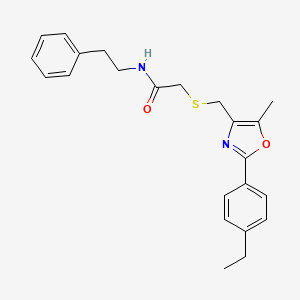

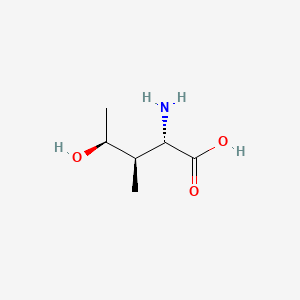
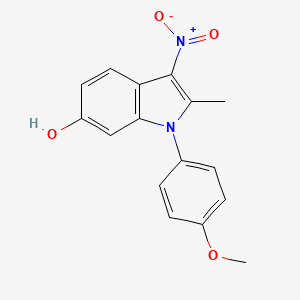
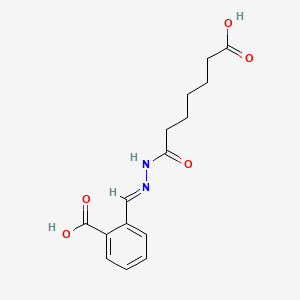
![10-(2-Chloro-6-fluorobenzyl)-8-(4-methylpiperazine-1-carbonyl)dibenzo[b,f][1,4]thiazepin-11(10H)-one](/img/structure/B1674374.png)
